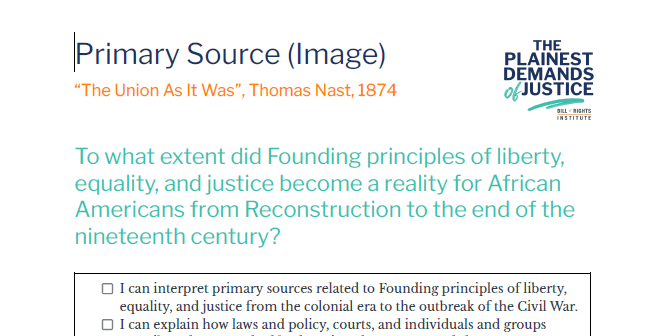Image: Thomas Nast, “The Union As It Was”, 1874
Guiding Question: To what extent did Founding principles of liberty, equality, and justice become a reality for African Americans from Reconstruction to the end of the nineteenth century?
- I can interpret primary sources related to Founding principles of liberty, equality, and justice from the colonial era to the outbreak of the Civil War.
- I can explain how laws and policy, courts, and individuals and groups contributed to or pushed back against the quest to end slavery.
- I can create an argument using evidence from primary sources.
- I can analyze issues in history to help find solutions to present-day challenges.
Building Context
Thomas Nast was a famous political cartoonist and influential contributor to Harper’s Weekly, a New York–based publication that featured foreign and domestic news, fiction, and illustrations. The following images by Nast appeared in Harper’s Weekly in 1874. Nast depicted a member of the White League and a Ku Klux Klan member shaking hands over a shield depicting “The Lost Cause.” An African American family cowers under a skull, while a schoolhouse burns and a man is lynched in the background.
Image: Thomas Nast, “The Union As It Was”, 1874
Source Link: https://en.wikipedia.org/wiki/Reconstruction_era#/media/File:The_Union_as_It_Was.jpg
The Union As It Was by Thomas Nast, 1874
Comprehension and Analysis Questions
- Compare Nast’s depiction of white supremacist groups with the description in Documents 8 and 9. Which do you find more effective? Why?
- Nast’s cartoon was drawn 3 years after the final Enforcement Act was passed. What does this reveal about Klan violence in the South?


